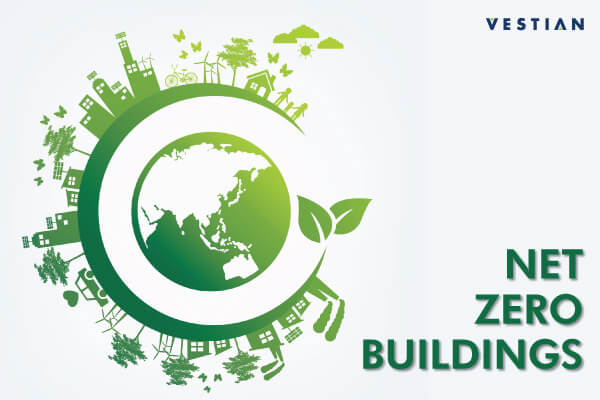
Used interchangeably, zero net energy or net zero energy building, meets its annual energy consumption through production of an equal amount of renewable energy on-site, thereby reducing the use of non-renewable energy resources.
Zero net energy buildings contribute significantly lesser greenhouse gases to the atmosphere. That being the case, many residential and commercial buildings are moving towards achieving zero net energy building status. These highly energy-efficient buildings comprise: Net Zero Site Energy (for every unit consumed, a unit must be generated), Net Zero Source Energy (depending on site and utility, this refers to the primary energy required for extracting, generating and wastage, while distributing the energy), Net Zero Energy Costs (energy bill amounting to $0), Net Zero Energy Emissions (emission free energy).
To be certified as a zero net energy building, every aspect of design, construction and operation needs to be carefully monitored. Measures undertaken to achieve net zero include efficient building design, optimized operations and maintenance, on-site renewable energy generation, and procurement of renewable energy, if need be. Building's energy load can be reduced via operational efficiencies, technology and design. The demand for energy and water can be reduced by use of natural ventilation, heating and cooling provided through radiant slab and panels, maintaining ambient temperature, use of LED lighting, adjustment of light and room temperature via sensors, compositing toilets (compost being used for plants), water saving fittings, increased use of natural daylight, electro chromatic glazing and shadow boxes on the glass facade to diminish solar heat gain, rainwater harvesting, recycling drainage water for irrigation and flushing, use of reverse osmosis filtration, induction diffusers that have a heating/cooling coil which removes the requirement of reheating air supply, addition of drought resistant landscapes and roof gardens that assist in keeping the building cool, gas heat pumps, batteries, collective heat and power systems to name a few.
In US, some examples of commercial buildings that have achieved net zero energy status are: Bullitt Center, Seattle, Washington; Maclay Architects Office, Waitsfield, VT; The Putney School Field House, Putney, VT; Chrisney Branch Library, Chrisney, IL; PNC Bank Davies & Andrew Branch, Fort Lauderdale, FL; Journey to Net Zero, Seattle, WA; DPR San Francisco Office, San Francisco, CA; West Berkeley Public Library, Berkeley, CA; American Samoa EPA Office, Utulei, American Samoa and many more.
Infact, in California, all new residential buildings must be net zero energy by 2020 and commercial buildings by 2030; along with retrofitting of 50% of the existing commercial buildings.
The National University of Singapore will have its first net Zero Energy Building on its Kent Ridge campus which will be built by 2019. The NZEB@SDE is a six storey building which will make use of sustainable and net zero energy features such as solar energy, large overhanging roof, floating boxes for cross breeze, lighting, natural ventilation and hybrid cooling approach along with a tropical architecture design. Singapore is in the process of retrofitting buildings, and the target by 2030 is to achieve the 80% Green Mark Certification for all buildings.
The Indira Paryavaran Bhavan is India's first net Zero Energy building; it has been constructed with the help of roof top solar power system and other energy efficient materials. Natural daylight accounts for 75% of its energy consumption 40% of other savings is through chilled beam systems deployed for air -conditioning. Energy efficient materials such as fly ash bricks, recyclable materials, outer wall insulation by rock wool, high reflective terrace tiles, doorframes and shutters built by renewable bamboo jute composite material, UPVC windows with hermetically sealed double glass, calcium silicate ceiling tiles, grass paver blocks for roads and pavements, low-discharge water fixtures, sewage treatment plant, geothermal cooling for HVAC system, rainwater harvesting and curing compounds have been used in the construction of this building.
These buildings offer uniform interior temperatures, lesser costs (though initial costs are higher), separation from future price increase, and a higher resale value. The energy efficiency improvements have been established from 60% to 90% and provide freedom from use of fossil fuels.
Buildings account for 40% of energy consumption; making it a major contributor to global CO2 emissions, which impact the climate adversely. Zero net energy buildings will not only reduce carbon emissions and dependence on non- renewable sources of energy, but also be a huge step towards a more sustainable future.